Géza Gárdonyi is usually referred to as the hermit of Eger, because of the writer's eccentric, closed and lonely nature. Gárdonyi (originally Géza Ziegler), born in Agárdpuszta on 3 August 1863, did not like the hustle and bustle of the big city, the densely populated streets, the busy squares, even though he lived in Budapest five times for shorter or longer periods.
For the first time as an elementary school student. His father, Sándor Mihály Ziegler, was in constant conflict with his employers due to his violent nature, so the family moved often. They lived in nearly twenty settlements until the writer's adolescence. In 1868, they spent a year in Buda. Gárdonyi later wrote about this year that he did not like Vurstli, but he liked the hills of Zugliget all the more.
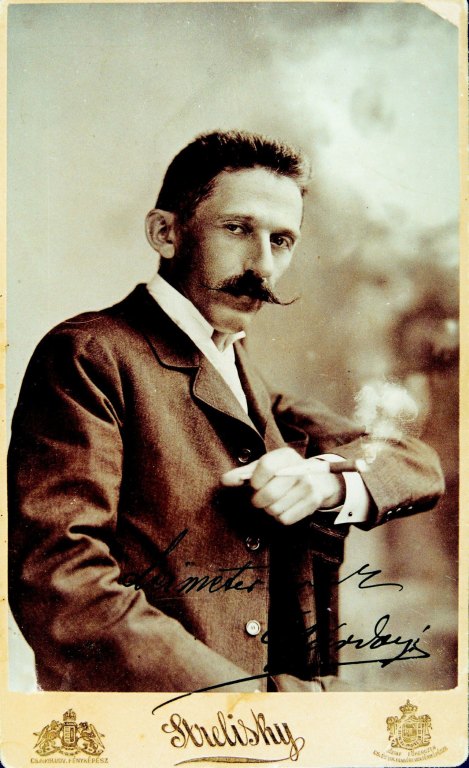
Géza Gárdonyi in her twenties in Strelisky's photo (Source: pim.hu)
The father enrolled the boy in the student home in Sárospatak, and he finally graduated from the Kálvin Square Reformed Secondary School in Pest in 1878. The environment of Kálvin Square was transforming around that time. The young Gárdonyi could already admire the Neo-Renaissance palace of the First Savings Bank of Pest completed in 1874 by the hand of Miklós Ybl on the plot with an irregular floor plan bounded by Kálvin Square, Múzeum Street and Baross Street. (The house was heavily hit during the siege after the war, and was then demolished by the city administration.)
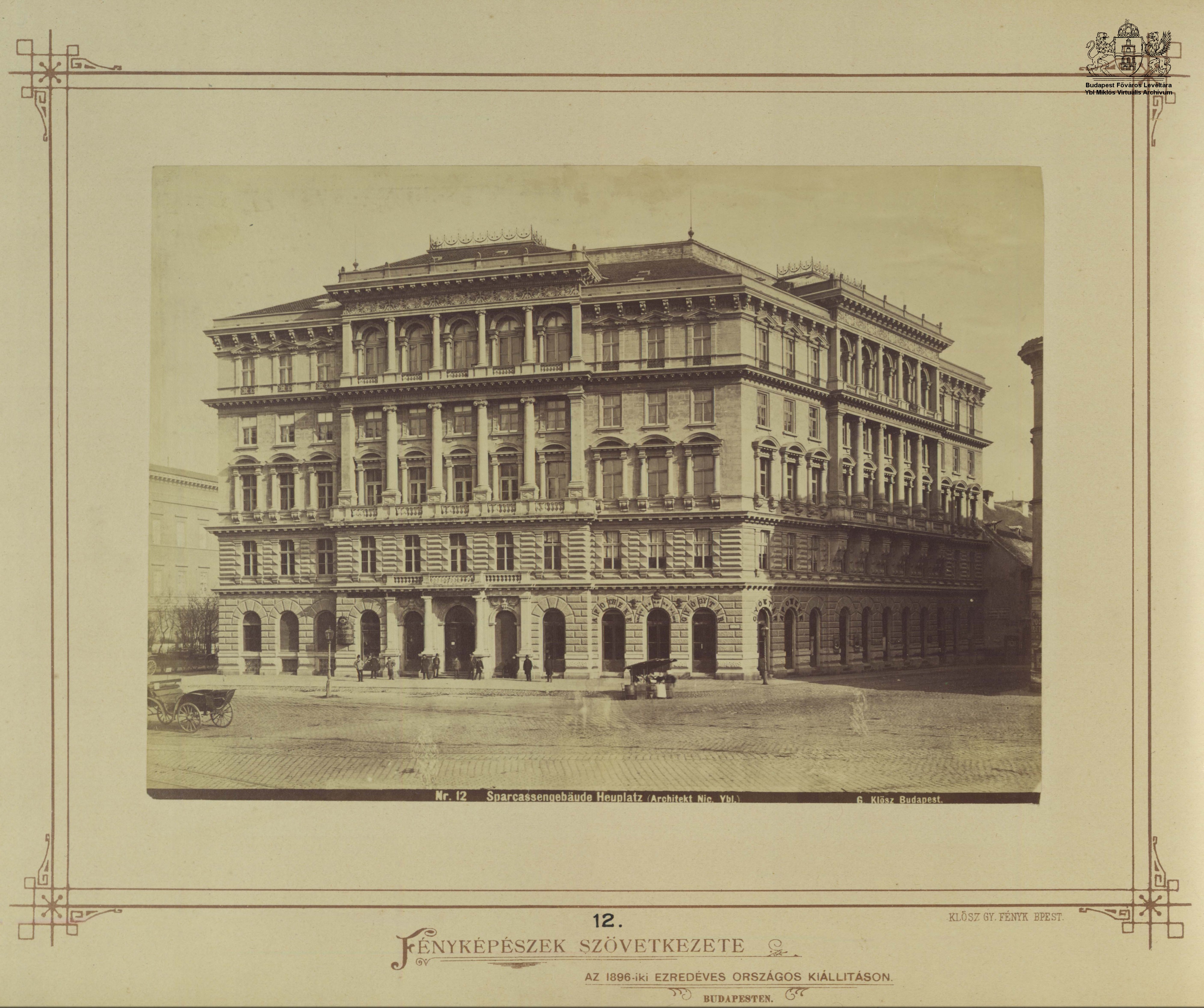
The building of the First Savings Bank of Pest was demolished after the war on Kálvin Square (Source: FSZEK Budapest Collection/György Klösz)
But the Magyar-Hollandi Biztosító Rt. [Hungarian-Dutch Insurance Co., Ltd.] building, designed by Károly Bergh and completed in 1869, also stood there. At that time, horse-drawn carriages used to run from the Zrínyi café on Múzeum Boulevard towards Kőbánya and Ludovika. The decision to arrange the Múzeum Boulevard had already been made (in 1870, but it took 10 years to complete). He lived and wrote his first poems in this changing environment of Pest, where he became increasingly familiar with fiction, such as Cervantes' Don Quixote, which had an elemental effect on him.
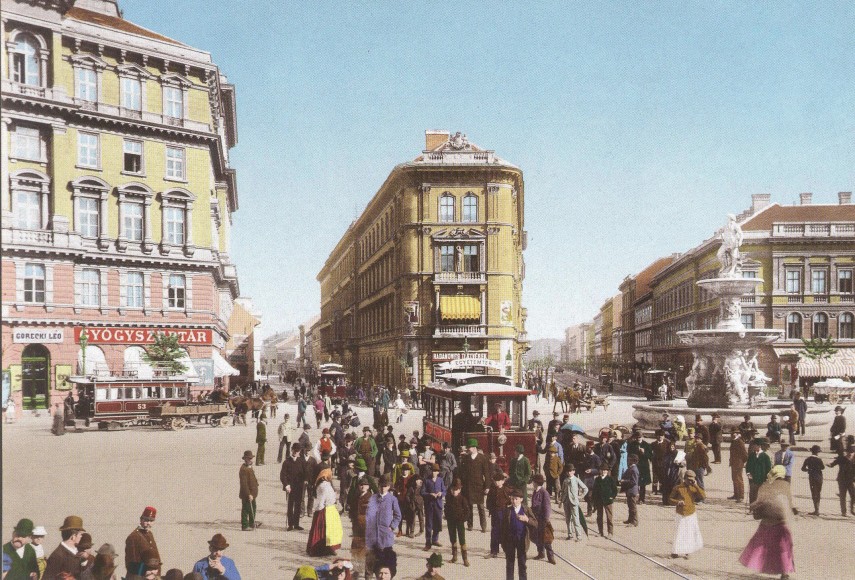
Kálvin Square in 1898. To the left is the demolished building of First Savings Bank of Pest, in the middle is the building of Magyar-Hollandi Biztosító Rt., and to the right is a now demolished building on the site of the headquarters of the Farmers' Insurance Cooperative. In the foreground is the Danubius Fountain. With the exception of the fountain, all three buildings were already standing when Gárdonyi studied at the Kálvin Square Reformed Secondary School (Source: oszk.hu)
After secondary school, he attended the Archbishop's Catholic Teacher Training School of Eger and then got a job in Győr. In the fall of 1886, he moved to Budapest again with his wife. They lived in an apartment in the house at 4 Lovas Road, in the 1st District, below the Castle in Buda. Here he edited the paper Tanítóbarát, and by then some of his articles were already published in Budapesti Hírlap, Egyetértés, and Pesti Hírlap.
Gárdonyi believed that the road to literary success led through Budapest, so although they returned to Győr in 1888, in 1891 he moved to the capital again with his family. He was awaited by his literary friends in Budapest: the former Eger student and celebrated writer Sándor Bródy and the poet Lajos Pósa. Their apartment was at 4 Dembinszky Street, where they lived from November 1891 to July 1892. The two-story Neo-Baroque house designed by Ernő Goldmann was built on the plot owned by Mór Fuchs at that time. After its demolition (according to some sources, it was rebuilt), the four-story eclectic apartment building that still stands today was built in 1926 on the order of Jenő Strausz and his wife.
In the year of Gárdonyi's arrival, on 11 December 1891, he became an internal employee of Magyar Hírlap. The first editor-in-chief of the paper started under the leadership of Albert Apponyi was Gyula Horváth, and the senior fellow was Kálmán Mikszáth. With the Göre Letters published in Magyar Hírlap (his writings about the humorous character of judge Gábor Göre), he was a hit with the public, and the number of subscribers also increased significantly.
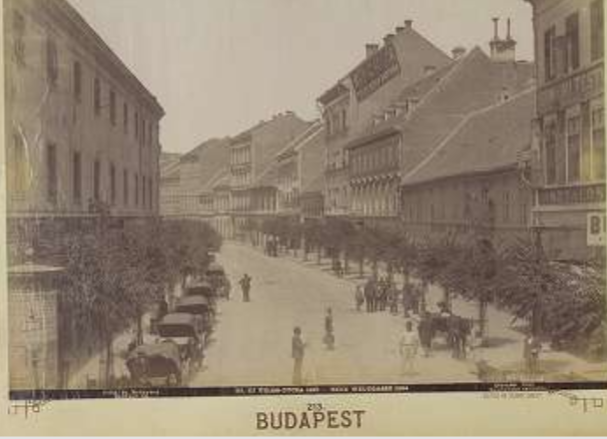
Újvilág Street (now Semmelweis Street) in 1894 (Source: hungaricana.hu)
At that time, the editorial office was located on the first floor at 14 Újvilág Street (now Semmelweis Street). From there, Gárdonyi - as the head of the political column - went to the Old House of Representatives every day, which met from 1866 to 1902 at 8 Bródy Sándor Street (today the Italian Cultural Institute). The one-story Neo-Renaissance palace designed by Miklós Ybl was completed in 3 months, and thanks to the excellent professionals, it is still the jewel of the capital today.
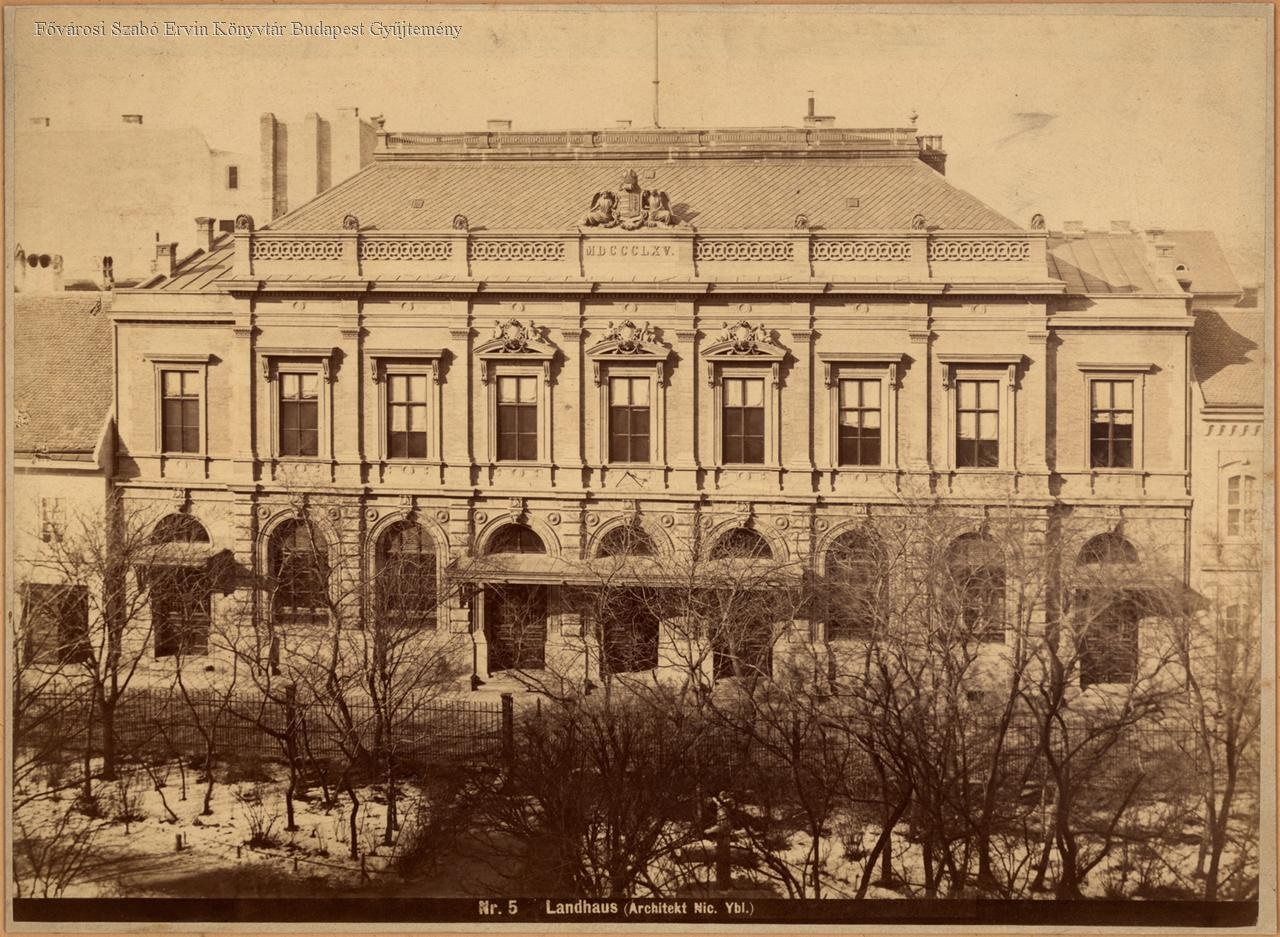
The Old House of Representatives on a photo by György Klösz, Gárdonyi used to go here every day to cover the meetings as a journalist (Source: FSZEK Budapest Collection).
Gárdonyi's days were therefore spent between the Újvilág Street editorial office, the Old House of Representatives and his favourite cafés. One of his regular places was the legendary Valéria café at 36 Üllői Road - 87 József Boulevard. "The Valéria café lived its withered, cheap life on the corner of József Boulevard and Üllői Road. The brighter Üllői Road wing constantly echoed with the clatter of billiard balls, young doctors counted the points and split the green cloth; the Boulevard part was a smoky, depressing, bleak room, reminiscent of the buffets of abandoned rural railway stations," - wrote Endre Illés. Here, Gárdonyi not only lived a social life, but also worked, and it even provides one of the locations for his work "Az öreg tekintetes" [The Old Honourable] (The honourable lord coming to Pest gets lost in Kálvin Square, where he admires the fountain, then goes on and enters a café, the like of which he has never seen before...)
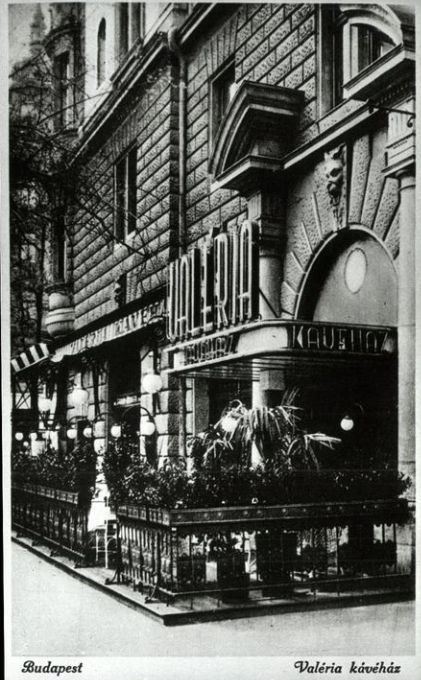
The Valéria café (Source: postcard/hungaricana.hu)
The corner building that also housed Valéria was built in 1892. In 1956, the building suffered minor damage, mainly in the corner. Restoration work took place in 1957-58. The upstairs parts of the house were restored, but on the ground floor, a row of arcades was created in the place of the former café. Although the café disappeared with this, other literary works preserve its memory, including the prose of Zoltán Ambrus, who lived in the house.
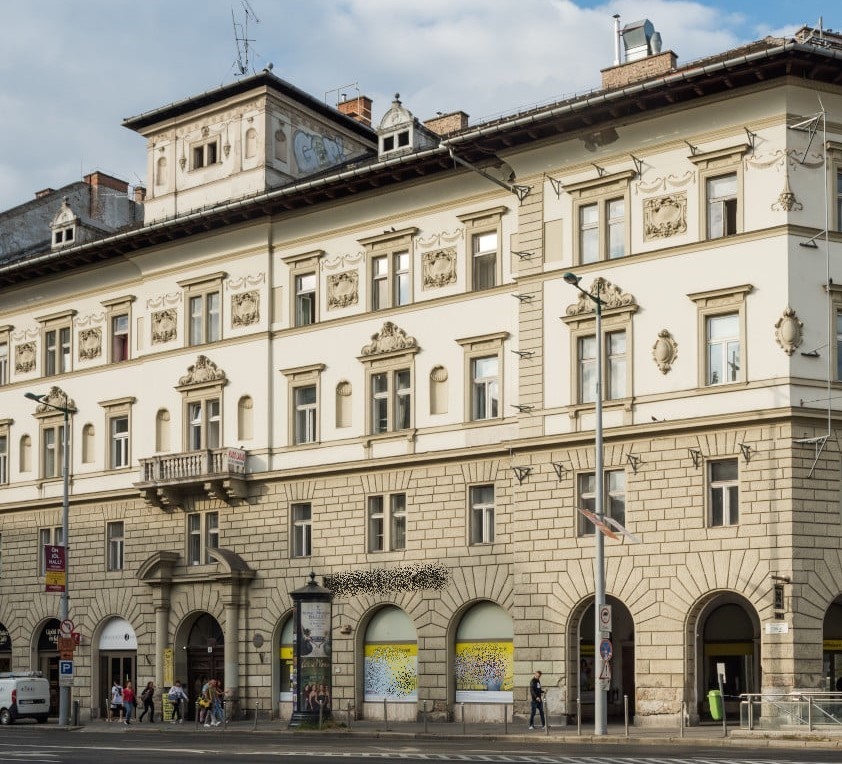
On the ground floor of the building on the corner of Üllői Road and József Boulevard, in the place of the arcades, the Valéria café was one of Gárdonyi's regular places (Source: lechnerkozpont.hu).
Gárdonyi, who was clearly an eccentric among artists, met Árpád Feszty thanks to his good friend Sándor Bródy and became the secretary of a business organised around the creation of the portrait "A magyarok bejövetele" [The Arrival of the Hungarians] painted by him. He won admission to the famous Feszty salon, that is, the Bajza Street salon of Árpád Feszty, Róza Jókai and Mór Jókai.
The salon operating in a one-story Neo-Renaissance building built in 1891 on the model of Venetian palaces was the most elegant artistic meeting place of the late 19th century. "The young village man sat with the dignity of an Olympian god at a table where the most valuable figures of the Hungarian writer and artistic world had gathered," Árpád Feszty once wrote about him.
And what he experienced in the company can be guessed from a diary entry from 1895: "After all such fun, I feel some kind of emptiness in my soul. It does not enrich me. I do not feel the soul-searching that I even feel when I see a flower. It takes it out of me, it dries me out. It depresses me.”
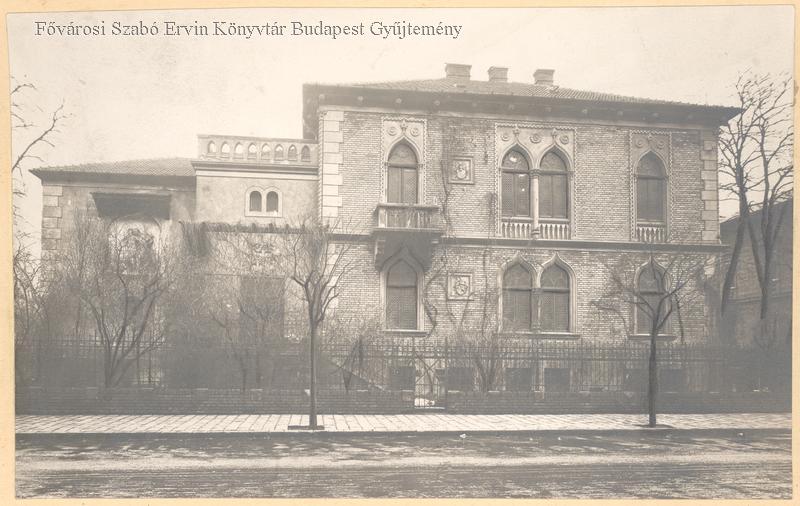
The writer was a regular guest of the Feszty Villa in Bajza Street (Source: FSZEK Budapest Collection)
He worked for Magyar Hírlap for five years (1891–1896), then his free railway ticket was revoked, so he transferred to Jenő Rákosi's Budapesti Hírlap.
According to his autobiography, in his early thirties, he increasingly felt that he had many topics, but that he could only process them in a quiet country place. Although he took long walks in the Liget, Zugló or even Hűvösvölgy, he regarded the fast-paced life of the big city with growing disinterest.
He finished his book "Az én falum" [My Village], then in 1897 he left Budapest and moved to Eger. Opposite the ruins of the Eger castle, he bought a small house in the Sánc district, where he began researching the everyday life of the Turkish occupation to write his historical novel, "Egri csillagok" [Stars of Eger], shortly after settling down. In addition, he had time for his other favourite activities: Gárdonyi was significant not only as a writer, literary translator and journalist. He painted, drew and created design renders for his plays. He composed music and played the violin, piano and cimbalom. He was particularly interested in natural sciences, he did fencing and played chess very well.
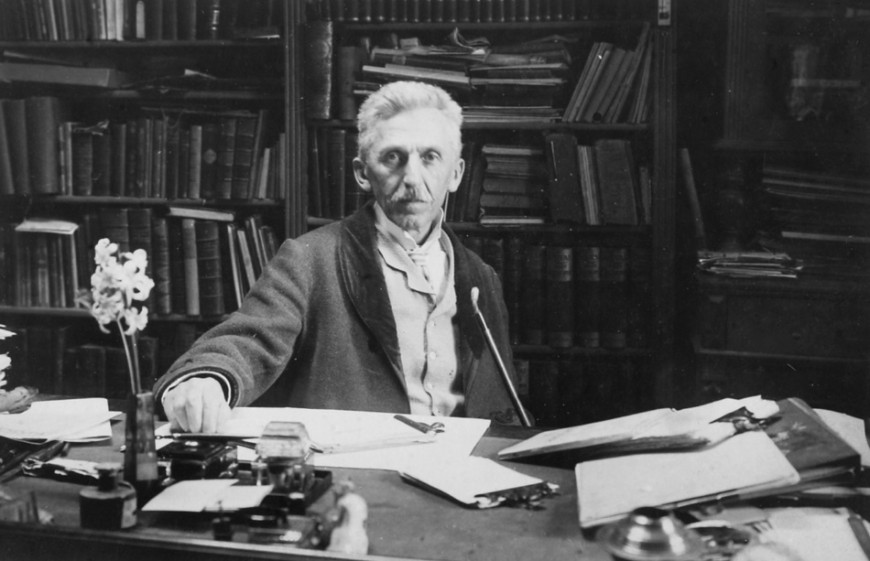
Géza Gárdonyi at her desk (Source: pim.hu)
By the time "A láthatatlan ember" [The Invisible Man] was published in 1902, he had decided that he would no longer move from Eger. But the writer could not completely separate himself from the capital. He kept a room near the Keleti (Eastern) Railway Station, on Aggteleki Street (today's Kiss József Street), from where he could easily reach cafés and editorial offices.
Travelling from Eger, he often went to the splendid New York café on the ground floor of the New York Palace, handed over in 1894 and designed by Alajos Hauszmann (9–11 Erzsébet Boulevard). Zsigmond Móricz also wrote about him in his article entitled Gárdonyi Gézánál [At Géza Gárdonyi]: "I once met him in the New York café at midnight. It was a long time ago. I was still a young writer at the time of the "Sári bíró" [Judge Sári, his first play]. He welcomed me very kindly and immediately warmed to me, "if I come to Pest," he said, "I should absolutely go to these two places." To this café and the Császár Bath. The mud there is good for my bones. Here it is good for my bile."
World War I hit the writer in Eger. In this period, his poems and short stories sound like hesitancy, hopelessness, and disappointment. He fell ill in 1922 and died on 30 October. The family of the writer, who always looked inward and lived quietly, organised a modest and intimate funeral, which was characteristic of him. He was buried on the Bebek Bastion of the Eger castle in the ornamental grave site donated by the city. A simple inscription on his grave proclaims: "Csak a teste..." [Only his body...].
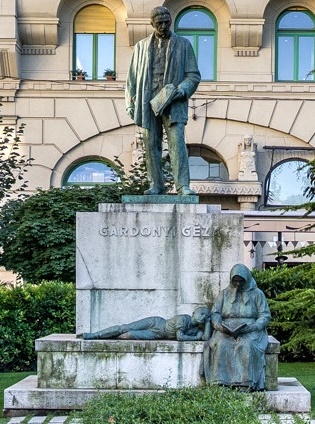
The group of statues was made by János Horvay on the occasion of the 10th anniversary of the death of Géza Gárdonyi (Photo: pestbuda.hu)
His monument, created by János Horvay, was erected in 1933 in Budapest’s 11th District, near Hadik Café in today's Gárdonyi Square. Ferenc Herczeg gave a speech on behalf of the Hungarian Academy of Sciences and the Kisfaludy Society, and Gyula Pekár gave a speech on behalf of the Petőfi Society. The central figure of the three-figure group of statues is the writer. Two statues were placed under it: a boy lying down and his mother sitting next to him in a shawl, reading to him.
Cover photo: Géza Gárdonyi's monument in the 11th District (Photo: pestbuda.hu)

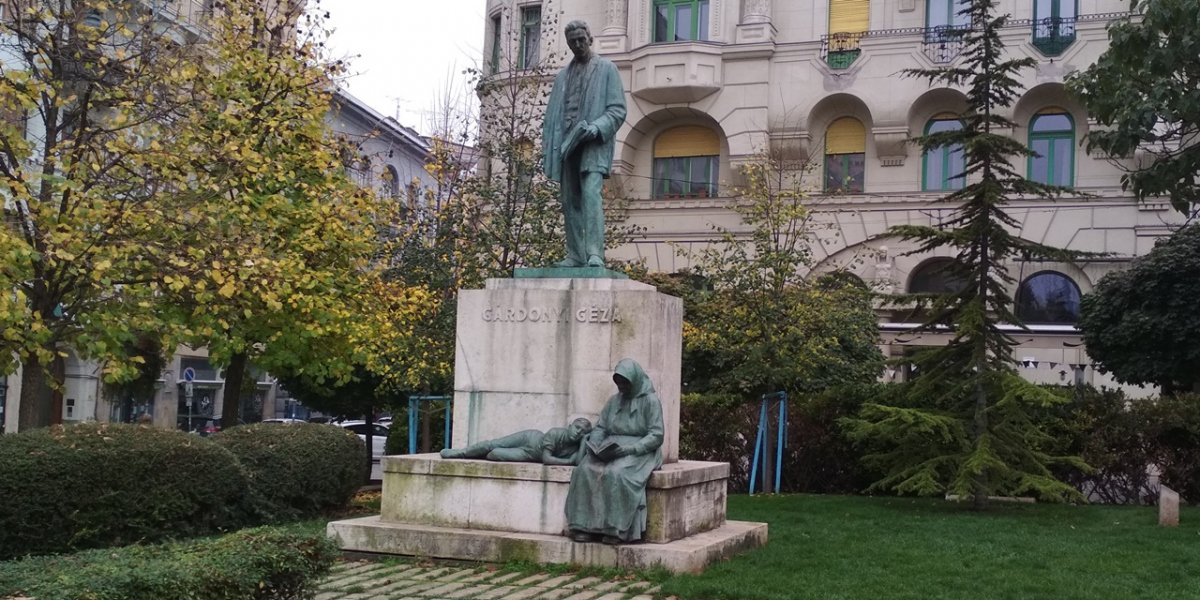
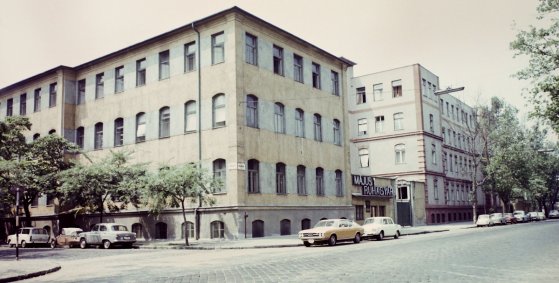

































Hozzászólások
Log in or register to comment!
Login Registration